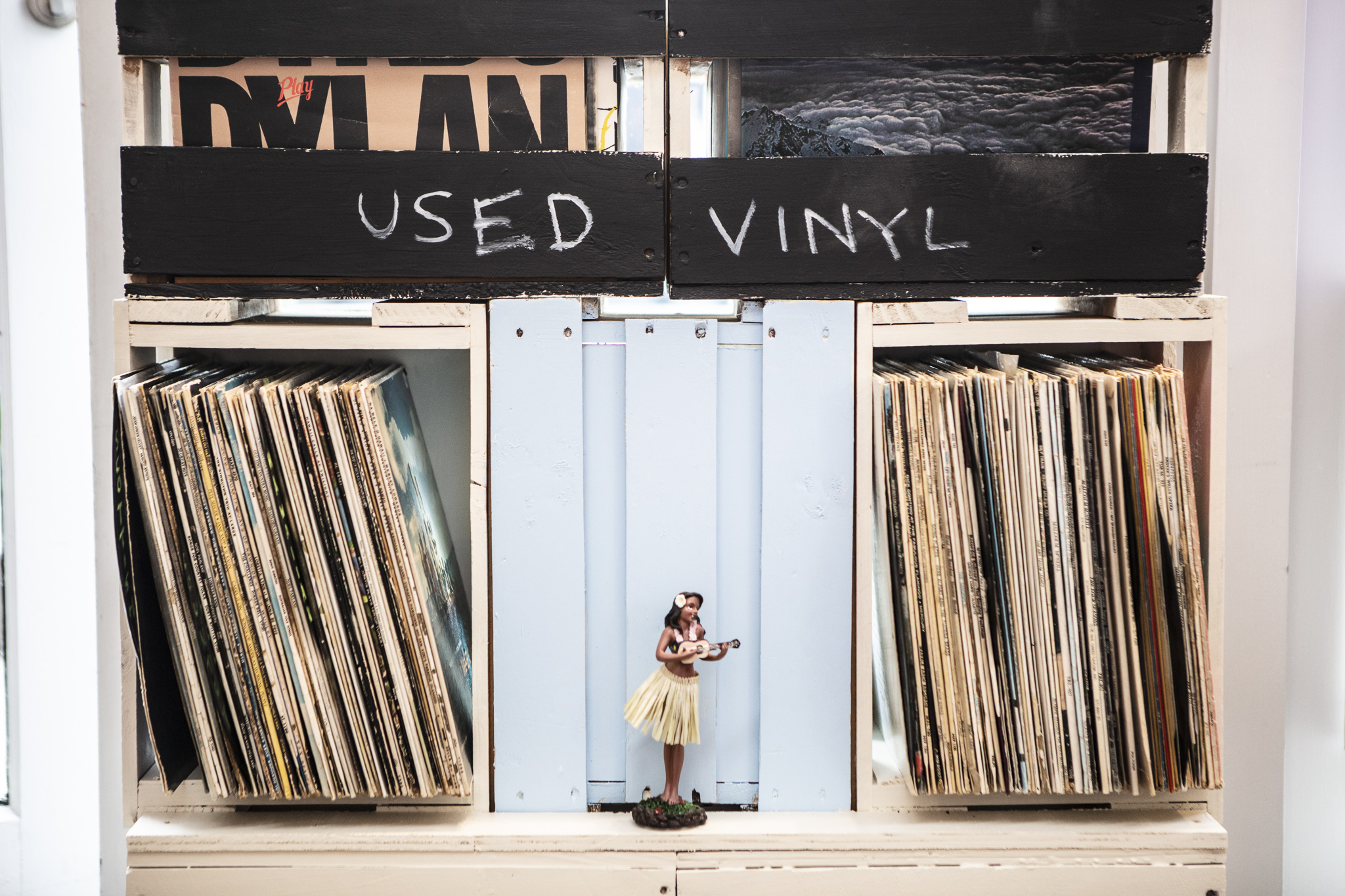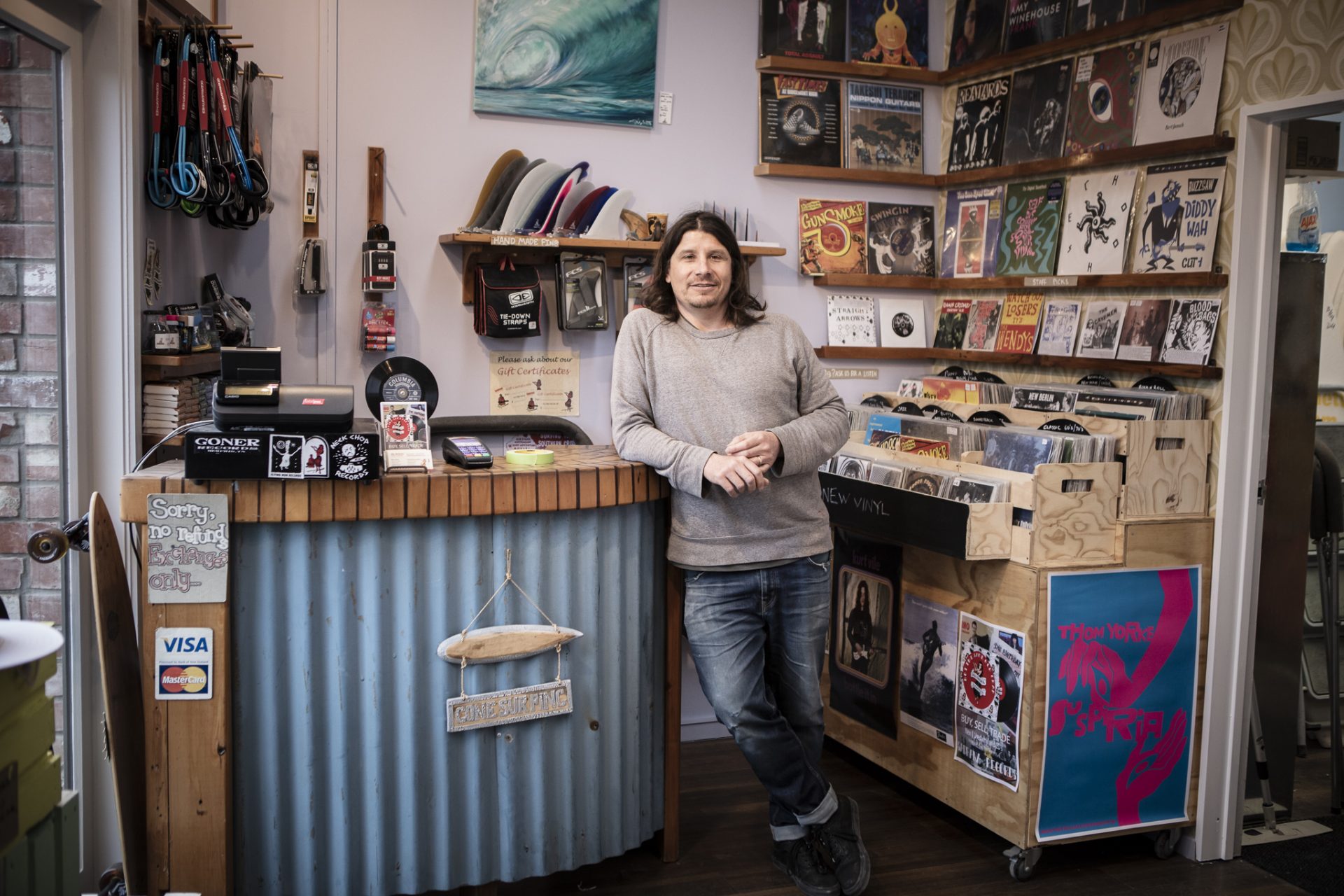I knew it was Jay standing there in the parking lot. It wasn’t because he wore the hair of a rocker, or that he stood in dusty jeans with a plain, unbranded mushroom-coloured jersey. It was the fine gradient of foam dust on his fingers that gave him away.
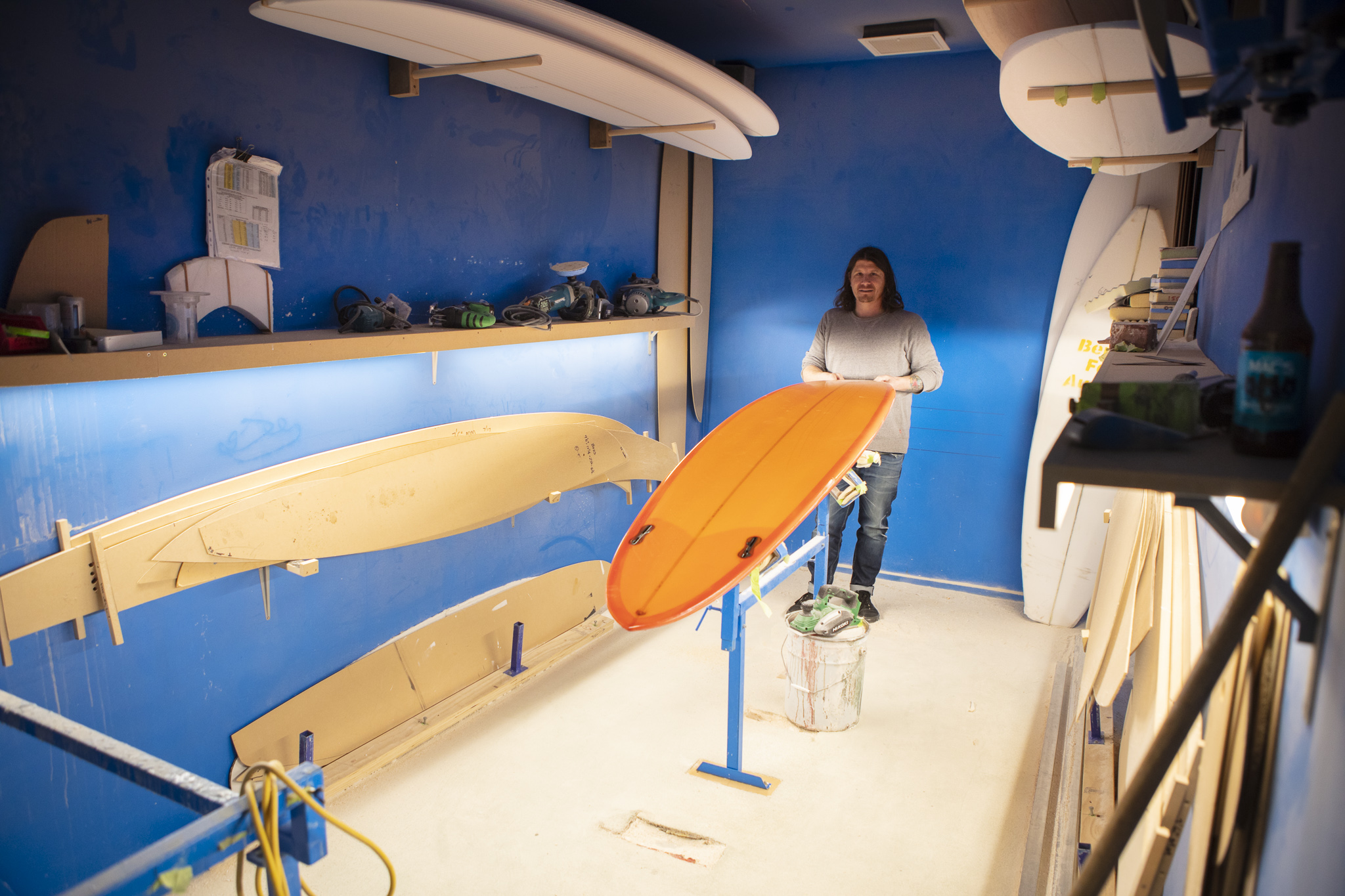
Since 2008, Jay Jackman and his wife Hana, have called Christchurch home.
“We did a bit of a tour around for two weeks in a campervan and liked it here,” he offers, as he shows me inside his shop in The Tannery – a boutique mall in Christchurch that sprung up after the earthquake. “So we just stayed, rented a house. It just seemed like a good move, especially for the type of waves here and up and down the east coast.”
I joke that he had the whole country to choose from and he chose Christchurch. He laughs.
“It’s only an hour and a half and you’re on the mountain – that was the draw card,” he adds with a nod to his passion for snowboarding. “We arrived around Anzac Day and the bar pumped that winter at Sumner. It was a bit different, a bit novel at the time … it was cool.”
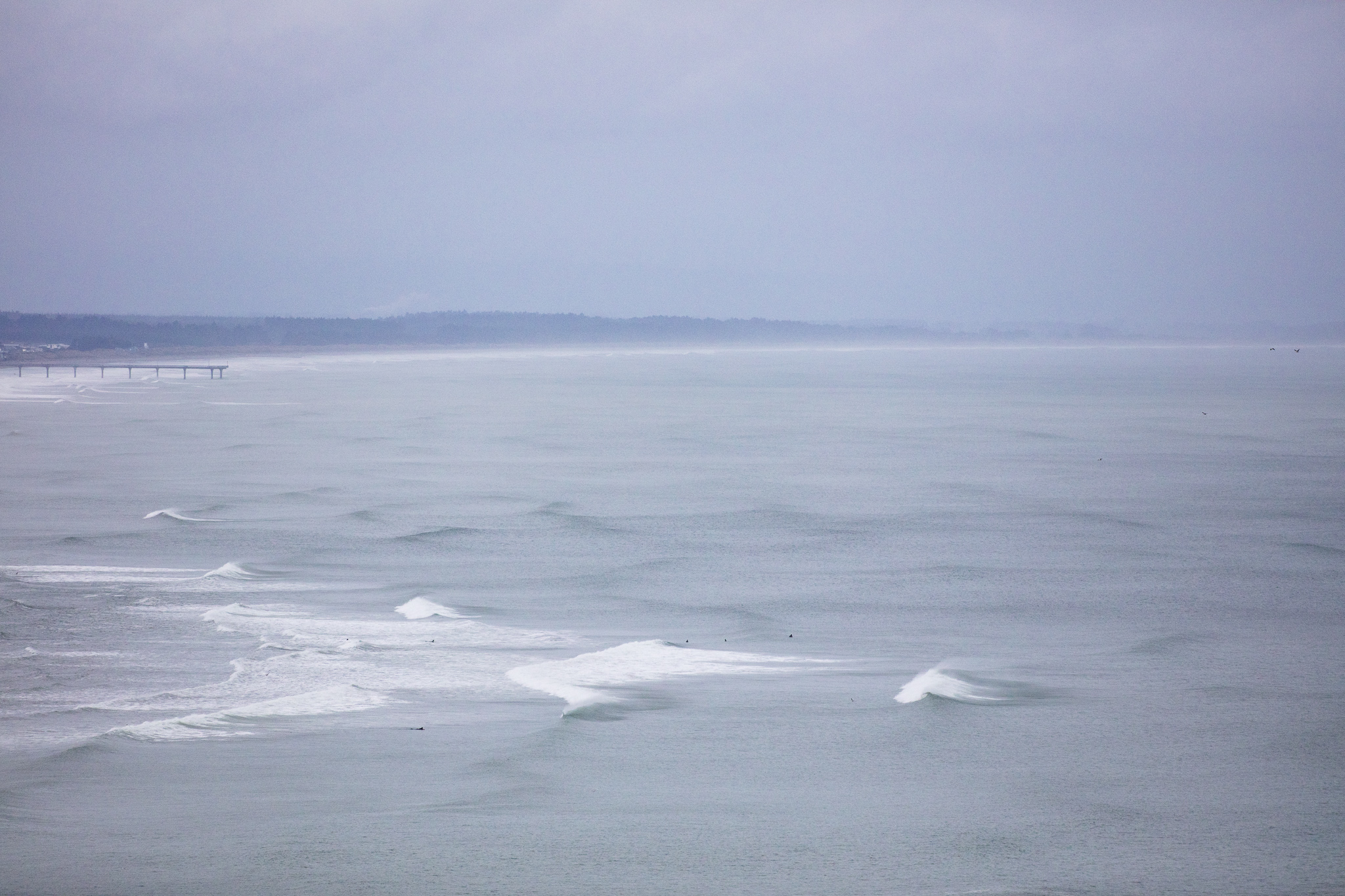
Jay, 44, is originally from Narrabeen on the Northern Beaches of Sydney. He arrived in New Zealand after a stint living in Cornwall, UK, and instantly saw a gap in the market in Christchurch’s surfboard manufacturing offering.
“There wasn’t anyone providing anything decent to surf on around here,” Jay explains. “I’d been living in Cornwall for long enough where the waves were a bit slack and English surfing was a bit slack as well. Having that background of how to milk the waves pretty well and I was like, well, why not, you know? And I like longboarding – the ethos is quite cool.”
So without hesitation, Jay, who’d been building boards for most of his adult life, started Sadhana Surfboards. He hung his hat on Christchurch and never looked back.
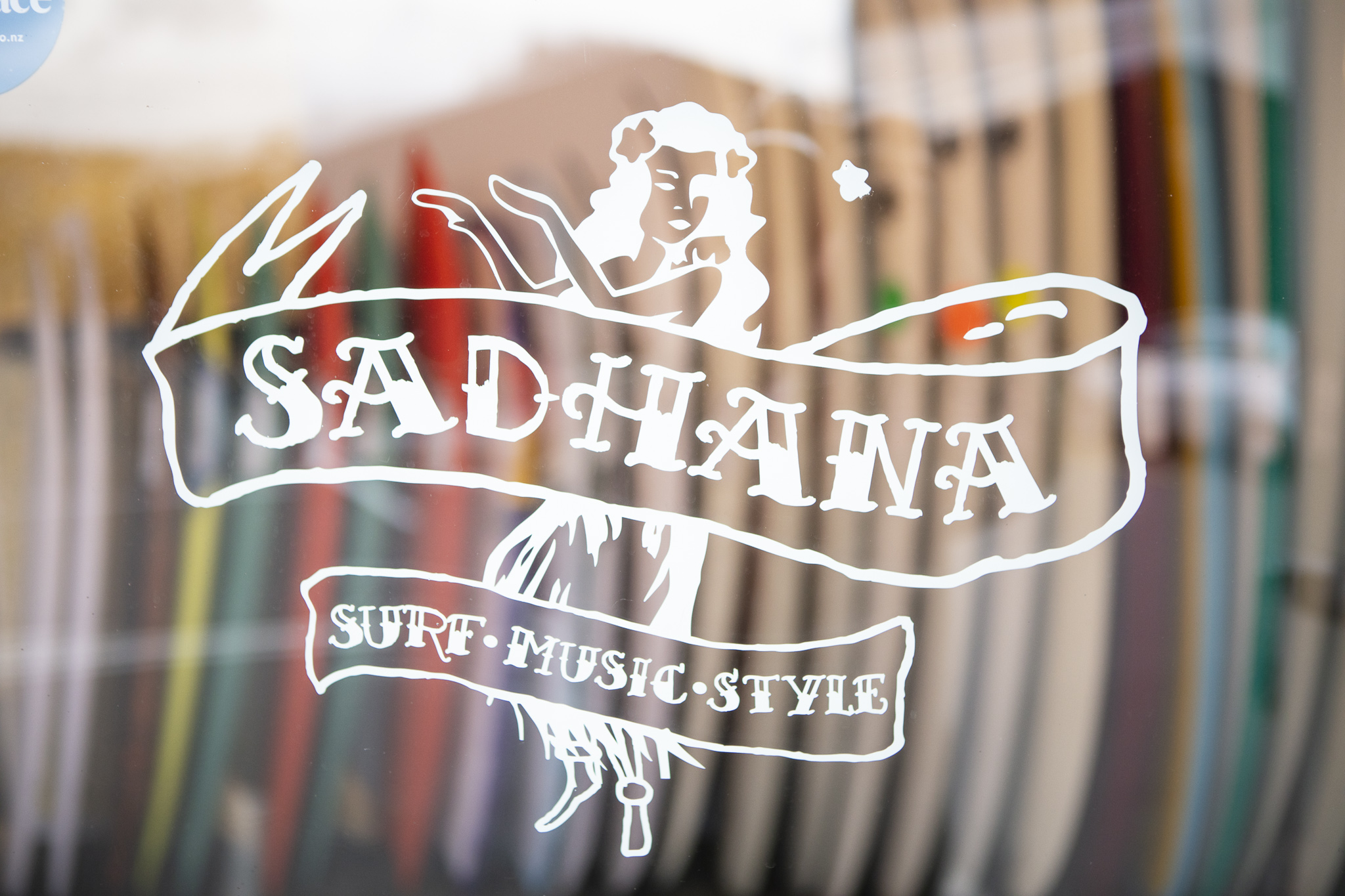
Sadhana is Sanskrit for “daily practice for the soul”.
“I found it in an old yoga text or something when I was lifeguarding and it sort of stuck with me,” he explains. “I thought yeah, that’s how I kind of kind of see it. Get up for the early and it kind of makes yourself better and your day better. It’s that full involvement of how surfing impacts your life and makes life better.”
On his wall hangs a framed black and white photograph of a surfer dropping into a giant wave at the Queenscliff Bombie in Sydney. It was taken in 1961 and the surfer is Jay’s uncle. He, and Jay’s Dad, were both board shapers. That makes him a second-generation shaper, but he didn’t want to put the Jackman name on his business.
“I just thought I’d rather have an ideal versus having to swan around as a salesman,” Jay admits. “My uncle had a reasonable name in New Zealand, up north: Dave Jackman. He was an Auckland board builder, boat builder and Mr Muriwai. He was quite well known in the surfing circles of the ’60s and ’70s. My Dad, also. They all had reputations in Sydney and Uncle Dave was in the Aussie team with Midget [Farrelly] that went to surf Hawaii back in the early ’60s. So they were mixed up with all those old blokes.”
“So I just thought, no, I just want to go out on my own.”
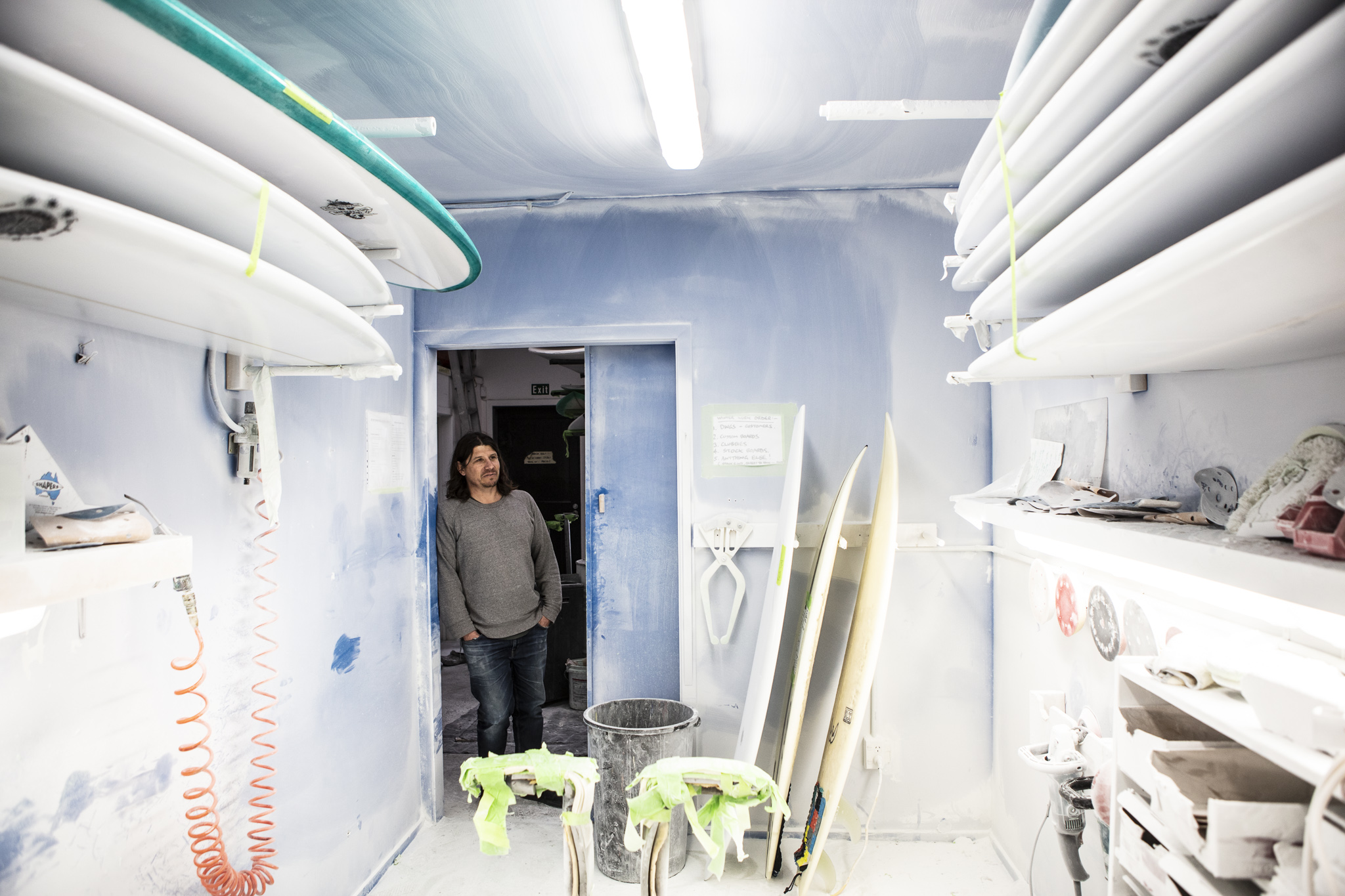
The hipster influence, born out of California, had emerged by 2008 and was changing the way people thought about surfing. In Australia, it was still stroking its pre-pubescent beard at that time. A world away in his Christchurch shaping bay, Jay started to rethink his board designs with the goal to have more fun in the surf. By happenstance, his thought process aligned with the trajectory of the hipster movement.
“Right about then was when that hipster influence from California was coming in,” he adds. “You know, where it was no longer about just smashing the biggest turn you can. That gave a bit of a nice new life to surfing: just go and have fun. It gave surfing a chance to just relax a little bit. Those days of going to Indo with a six-bag quiver filled with boards with one-inch difference – all that kind of shit was over.”
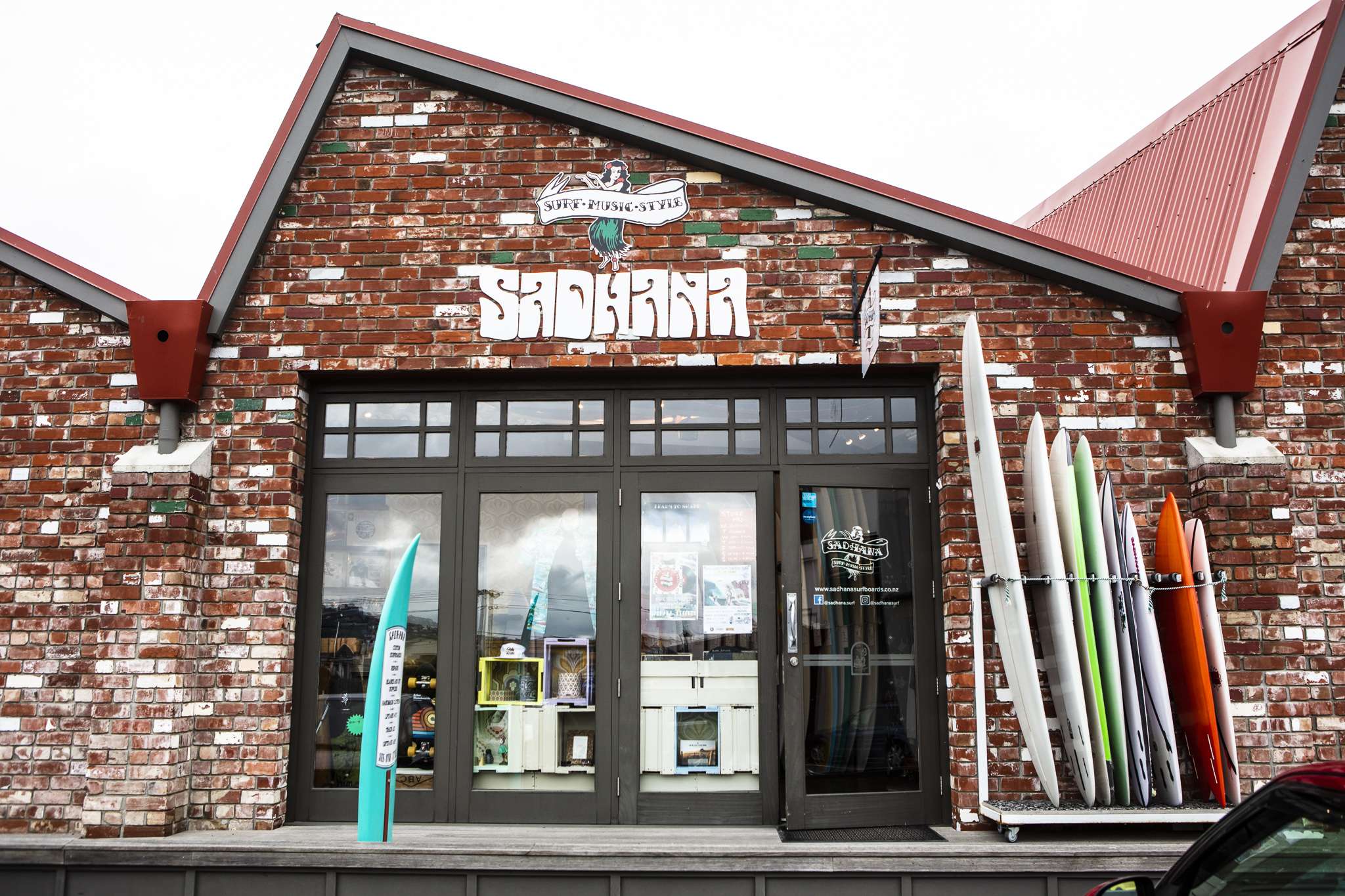
In so many ways the hipster movement was the antithesis of what had defined surfing on the Northern Beaches of Sydney, where Jay had grown up.
“I hated the Northern Beaches in the end,” Jay smiles with a shake of his head. “I hated it. I just hated that mentality. I don’t even surf when I go back to Sydney now – I just go for a swim or a body surf.”
Christchurch just ticks a lot of boxes for Jay, his wife Hana and their 14-month-old daughter.
“It sucks you in,” he laughs. “That first year we arrived the bar was so good – it was like one of the best years in 20 years. And it was like, fuck, this place is awesome.”
“Christchurch is a good base,” he considers. “I set up and have guaranteed myself a job and I made myself a business. So that’s how we see it – we see this like a gateway to getting around. We just got back from taking the family up to Castle Hill for the weekend – we were at Porters for the past few days snowboarding. We took the little one tobogganing and she loves it. So, yeah, you don’t get as many good waves here, but I like it, we travel around and you’ve got decent waves if you want to travel in the South Island.”
Jay’s early shaping ventures started in Sydney in the mid-’90s where he rented the occasional bay in between shifts as a lifeguard. It was here that he started to experiment with boards that drifted a long way from the trends of the time – back before the term “hipster” was even a thing.
“I was making boards that were halfway between a shortboard and a twinny,” he explains grabbing a board out of the rack. “I took one of these and surfed around Winki and Bells and Tasmania and all sorts of places on boards like this. Pretty much, 19-and-a-half to 20” wide, 5’8” or 5’9” – that sort of thing. But 25 years ago people thought you were on acid or something. These days this is like a pretty standard-sized board to have in a shortboard quiver.”
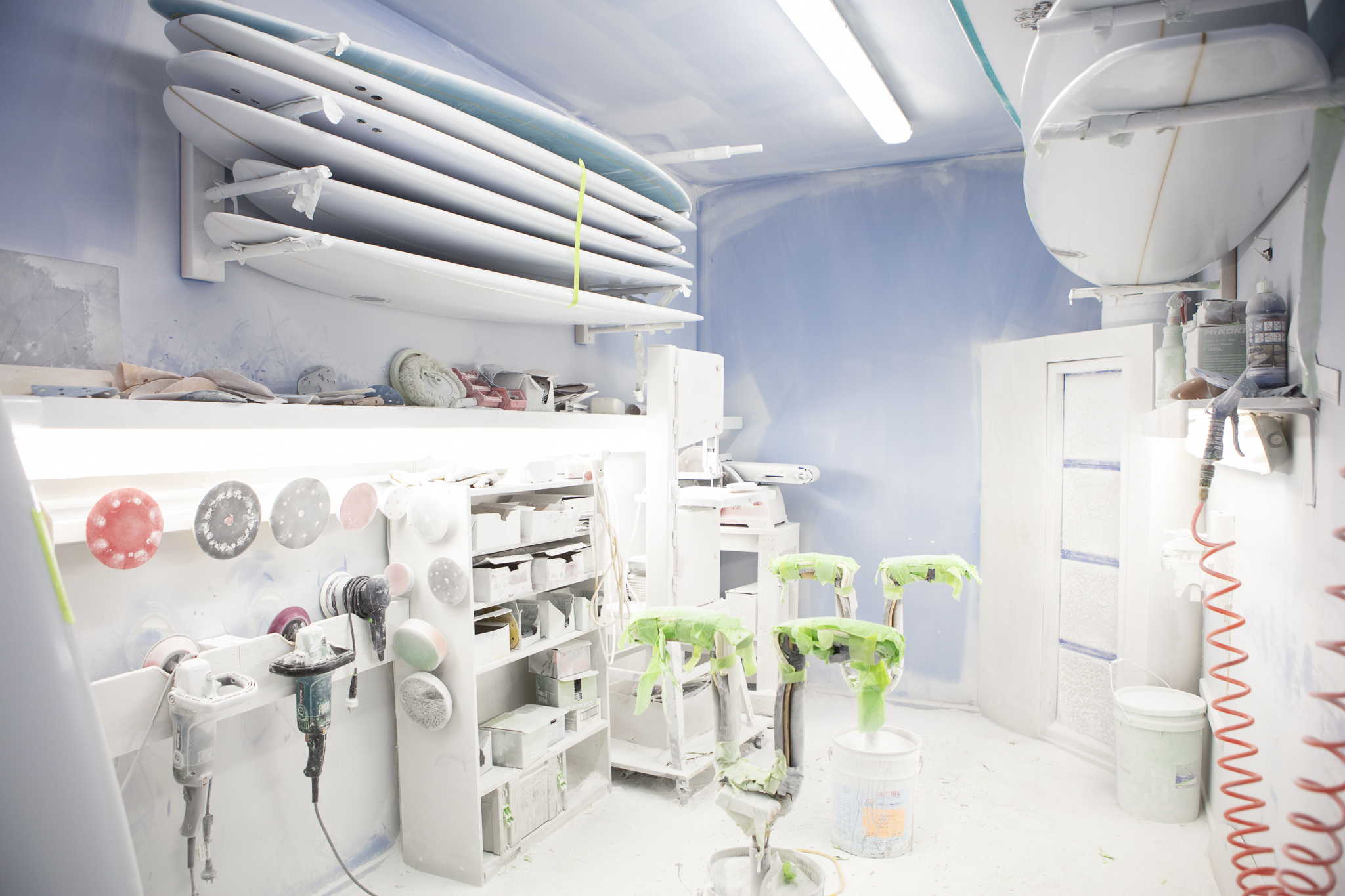
Many say that surf culture’s heyday came in the ’60s before the corporates swooped in to cash in and turned it into something else entirely. It’s clear that Jay draws his inspiration from that deep wedge of history when the purist form of surfing still held sway.
“I liked the old school stuff,” he states, unapologetically. “My Dad made boards and he used to have a mad collection of really out of it late-’60s surf mags at home. Magazines like Surfer and Surfing with writers like Drew Kampion – all that kind of carry on he used to write about. When you’re 13 and 14 you read that and you get quite into it. Then you read Surfing Life or something and it’s just hard to make the correlation between the two. It was like, fuck, these guys were out of it in the ’60s and now we’ve got these blokes around Narrabeen posing their heads off.”
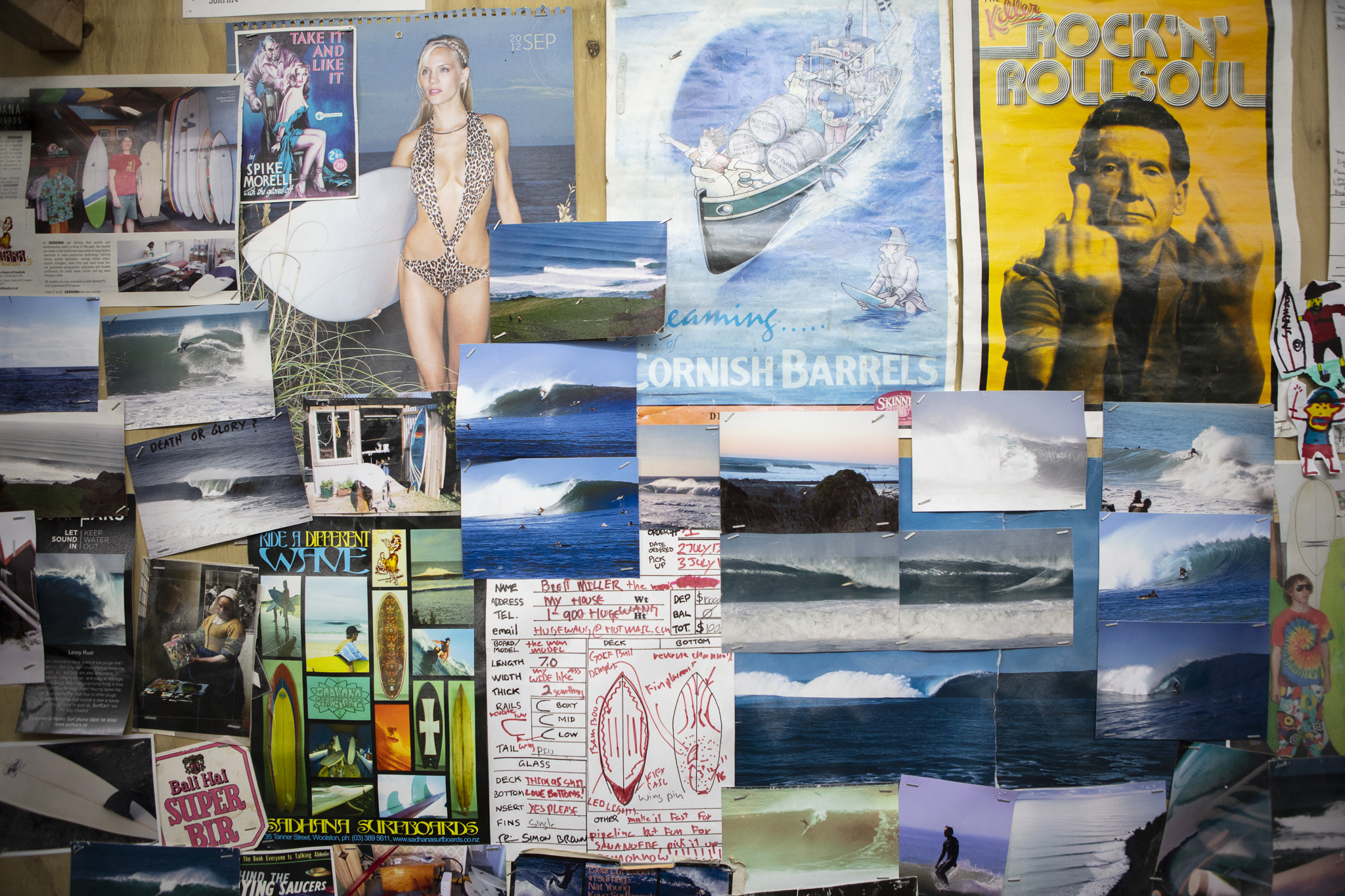
But the literature-rich surf mags weren’t the only influence for Jay.
“The whole Litmus thing was pretty influential for me at 19 or 20 years old, too,” he shares, reflecting on the 1995 surf movie that the Australian surf industry snubbed its nose at, at the time, yet it went on to inform a generation. “The whole [Andrew] Kidman thing and when they went to Ireland and did all that, the fishes, and the Steve Lis thing that [Derek] Hynd was doing … it just looked like fun. I think the shapes look quite cool. They look like cool old cars. And it was quite fun and you didn’t have to pay a fortune to get one out of a garage sale.”
“My Dad made boards and he used to have a mad collection of really out of it late-’60s surf mags at home. Magazines like Surfer and Surfing with writers like Drew Kampion – all that kind of carry on he used to write about. When you’re 13 and 14 you read that and you get quite into it. Then you read Surfing Life or something and it’s just hard to make the correlation between the two. It was like, fuck, these guys were out of it in the ’60s and now we’ve got these blokes around Narrabeen posing their heads off.”
Someone had an old ’70s Byron twinny under their house and Jay recalled constantly taking it to the beach. This was in the ’90s – in the peak of the Kelly Slater-driven, wafer-thin, rocker-bowed, 6’1” shortboard homogenisation of surfing equipment.
“We’d just surf old McGrigor single fins in the summer, because we didn’t want to ride a thruster,” Jay reveals. “Generally it was junky surf living in Sydney with nor’easters all day. I remember thinking, hey, there’s something in this. So, I have just gone with that – mainly flatter rocker lines and how short can you go? And then you go too short, and then you go a bit longer and it has just grown from that.”
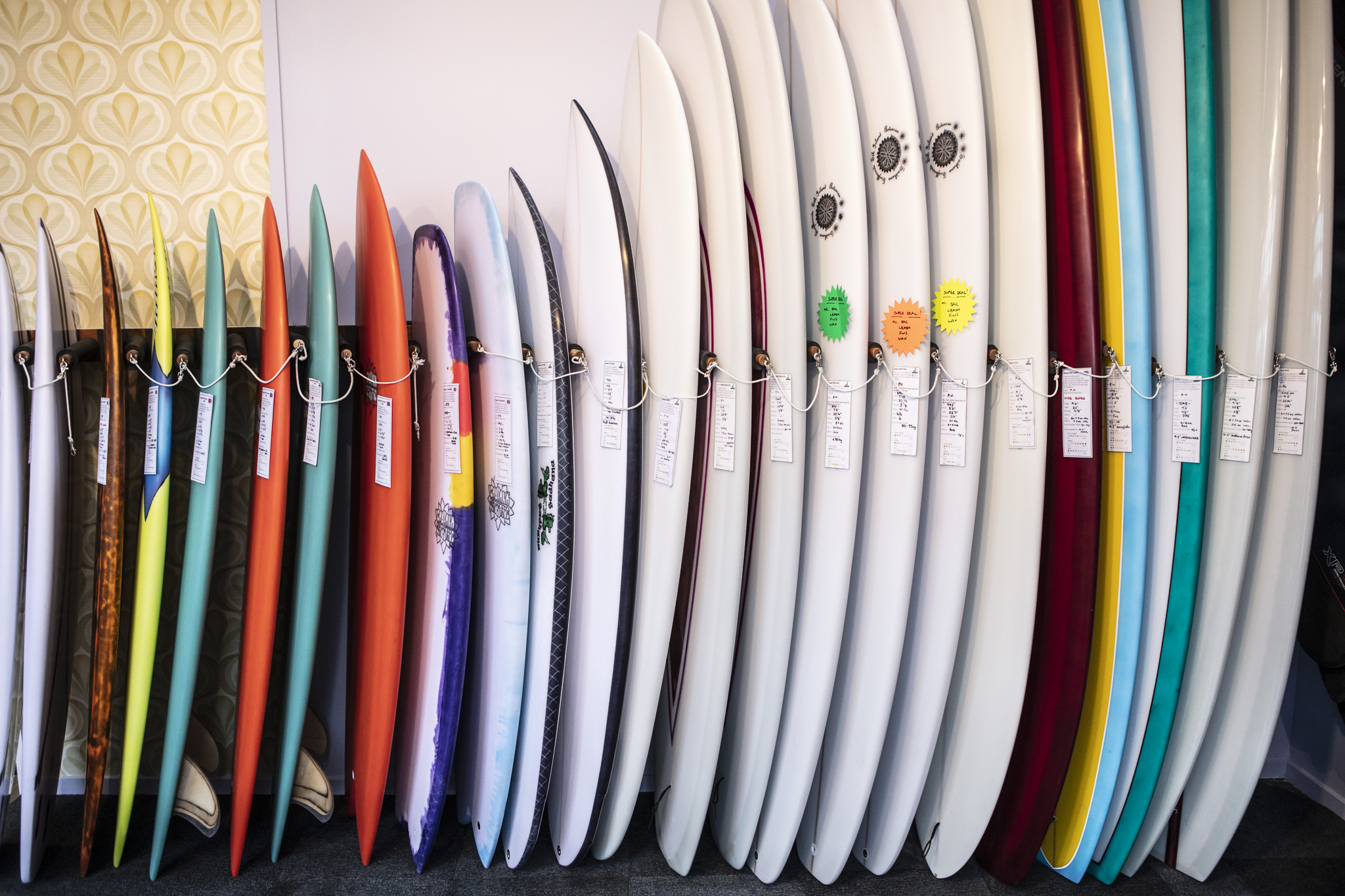
Jay said he never copied anyone’s design, but admitted the fish was the backbone of these types of shapes.
“It’s funny – it seems to be more popular now than it’s ever been,” he smiles. “I thought it would dip by now. We’re pretty much one of the first – definitely around the South Island – who was really concentrating on that stuff. I thought it’d go away, but this last couple of summers it just seems like everyone wants a keel fin. It’s crazy – they’re just easy to ride.”
While Jay doesn’t deal through any surf shops he said he was still sending boards all over the country and that was mainly fish variations.
“The log crew locally get boards, but it’s definitely a fish market,” he tells me. “To me everything is a variation of a fish. I mean all the shortboards now, even those the pro guys are riding, are all wider, shorter and flatter than they were 10 years ago. I think that’s quite cool.”
He pulls an unusual-looking board from his rack. It has a big blunt nose like a seven-giller. It’s labelled The Coalminer and he describes it as a “cut-off South Island fish template through the middle of the board”.
“Essentially, it marries up a mini-Simmons with a fish,” he explains. “I got right on the mini-Simmons trip around 2010 and 2011. I took a few to Indo actually – to Lombok. Not the Indo that everyone thinks of with the draining coral barrels, but good powerful wally waves.”
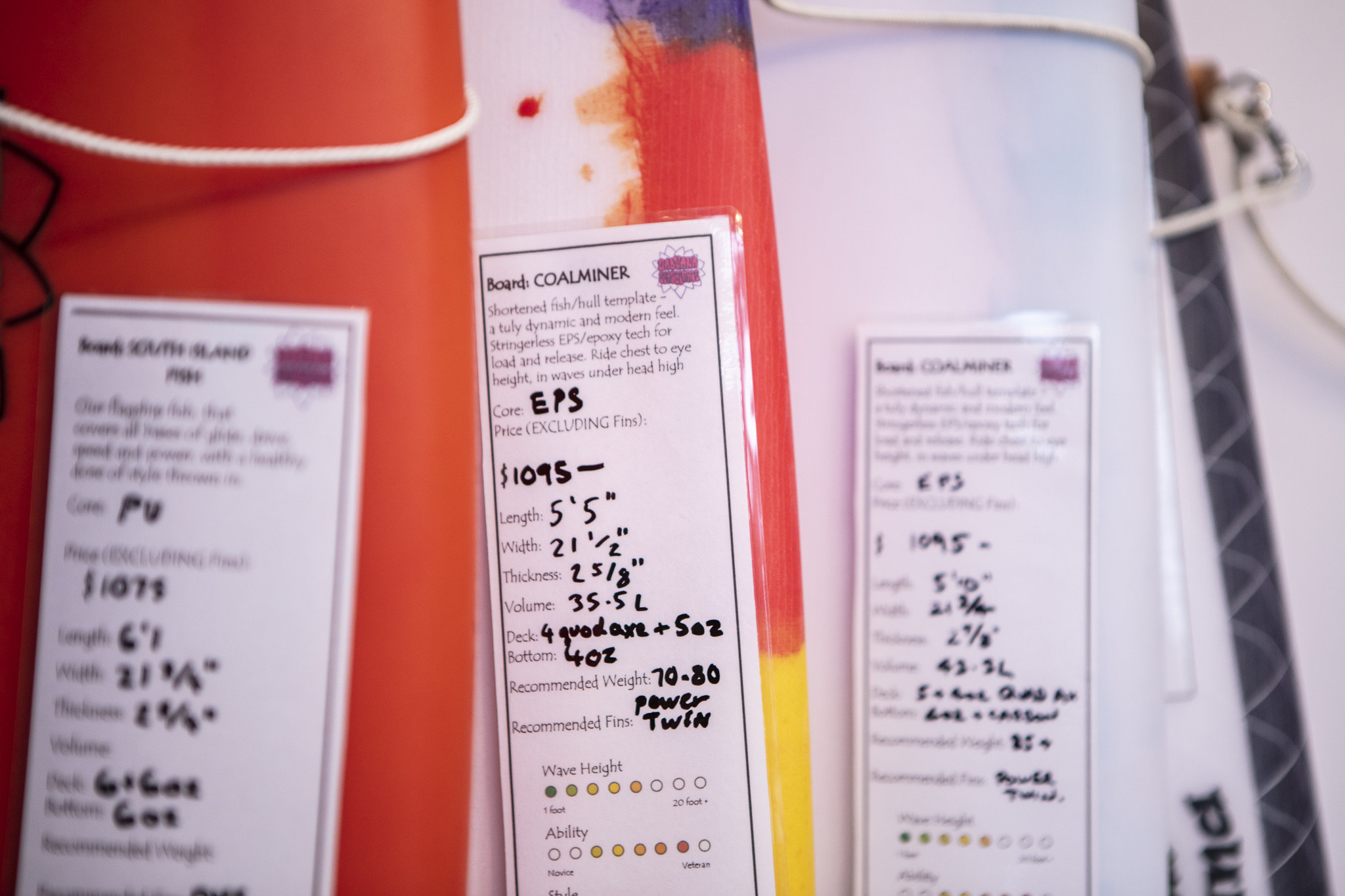
Jay remembers the genesis moment of The Coalminer.
“I was just having a bit of a brain expansion one day I suppose – how to marry up something,” he reveals. “Simmons are a bit different – you’ve got to nurse them around a bit, but they fly down the line and are really fun to ride. They really, really change your perception of how to surf down the line.”
“So, I thought how do you marry up a fish, which is nicer off the tail, but still have a rolled entry front?,” he recalls. “It looks like a shovel at the front and I have ridden one at T-Bay at high tide and it goes pretty good. That’s the new thing that we’re pushing along. They come in a 5’2″, 5’4″ and 5’5″ – that kind of size and with a big litreage for a shortboard. We try to be all techy with them as well and do some out of stringerless epoxy.”
“I suppose that’s the focus of what I like to do now,” he adds. “I don’t like that word retro – these are functional shapes and you can do them in cutting edge, up-to-date materials. You can join the two together. It’s not like you need to wear a rabbit skin hat and listen to Charles Manson records.”
“I don’t like that word retro – these are functional shapes and you can do them in cutting edge, up-to-date materials. You can join the two together. It’s not like you need to wear a rabbit skin hat and listen to Charles Manson records.”
The market has changed, too. Jay said his customer profile was very broad.
“It used to be just a hipster sort of crowd that liked to get a single fin, but now you’re getting guys who have a bag of JSs at home or Channel Islands and they’ll come in for a 5’6″ fish,” he explains. “Or you’ll get some loggers that’ll come in and they want a fish because it marries in the family.”
“The Japanese coined it – they call them transitional boards because they’re kind of in the middle,” Jay offers. “They solve the problem. It doesn’t matter what way you surf, whether you’re a cruiser, a glider or a shredder. You can do anything on them. I’ve got mates of mine that are like Bluff veterans up WA and Gnarloo. One of my mates camped out for five months a year for nine years in a row and that’s all he rides now is one of these around here.”
“But it’s funny the quivers that these guys have – you can’t pick it anymore,” he adds. “People have got a bit more adventurous, which is good. I think that when people first walked in here [Sadhana Surfboards showroom] they were a bit sheepish – maybe thought they were going to get some sort of sermon or something thrown at them. But no, it’s just a bit of colour and just about being a bit unique.”
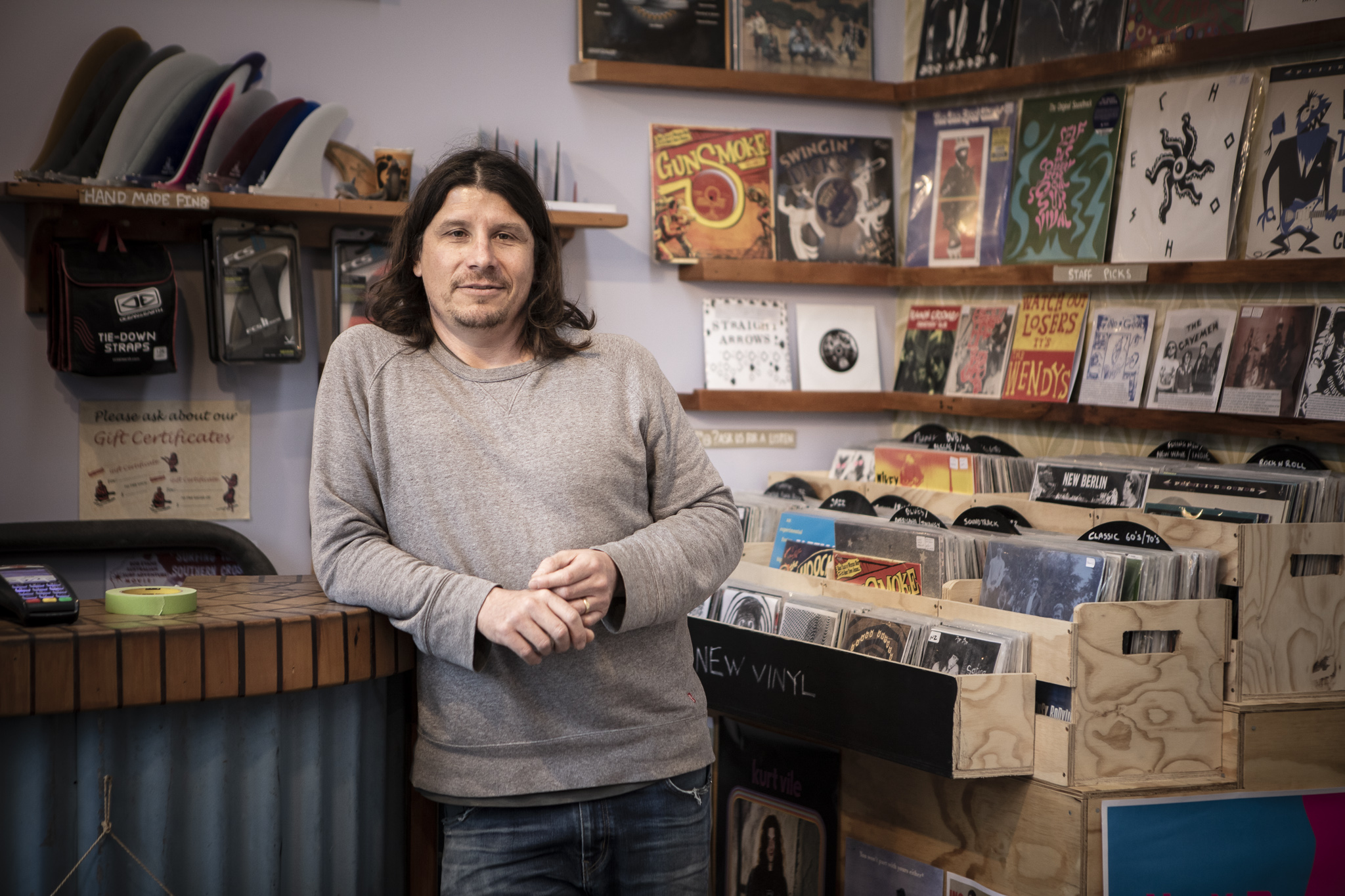
Behind Jay, on the shelf, sits an eclectic collection of fins. They’re all hand-made by Jay and his team and look like the boards they’ll one day adorn would lie somewhere on the spectrum between function and art.
“When we started we had to foil all our own fins – glass them all,” he offers. “We still like to foil all our own single fins – it keeps it all a bit purist and no one’s really doing it much anymore. That’s what I like to offer is that experience of what I remember as a kid – when you got a board someone foils the fins and sticks them on for you and that is a surfboard. But now the companies have crept in and they’re very dictating – this goes with this and everything’s in the box. It’s nice to remind people that it doesn’t have to be like that. It’s okay for ease of choice sometimes and especially for making boards feel different – I think it’s a good thing to a point, but it doesn’t always have to be like that. You know,” he smiles. “Without being rude about it.”
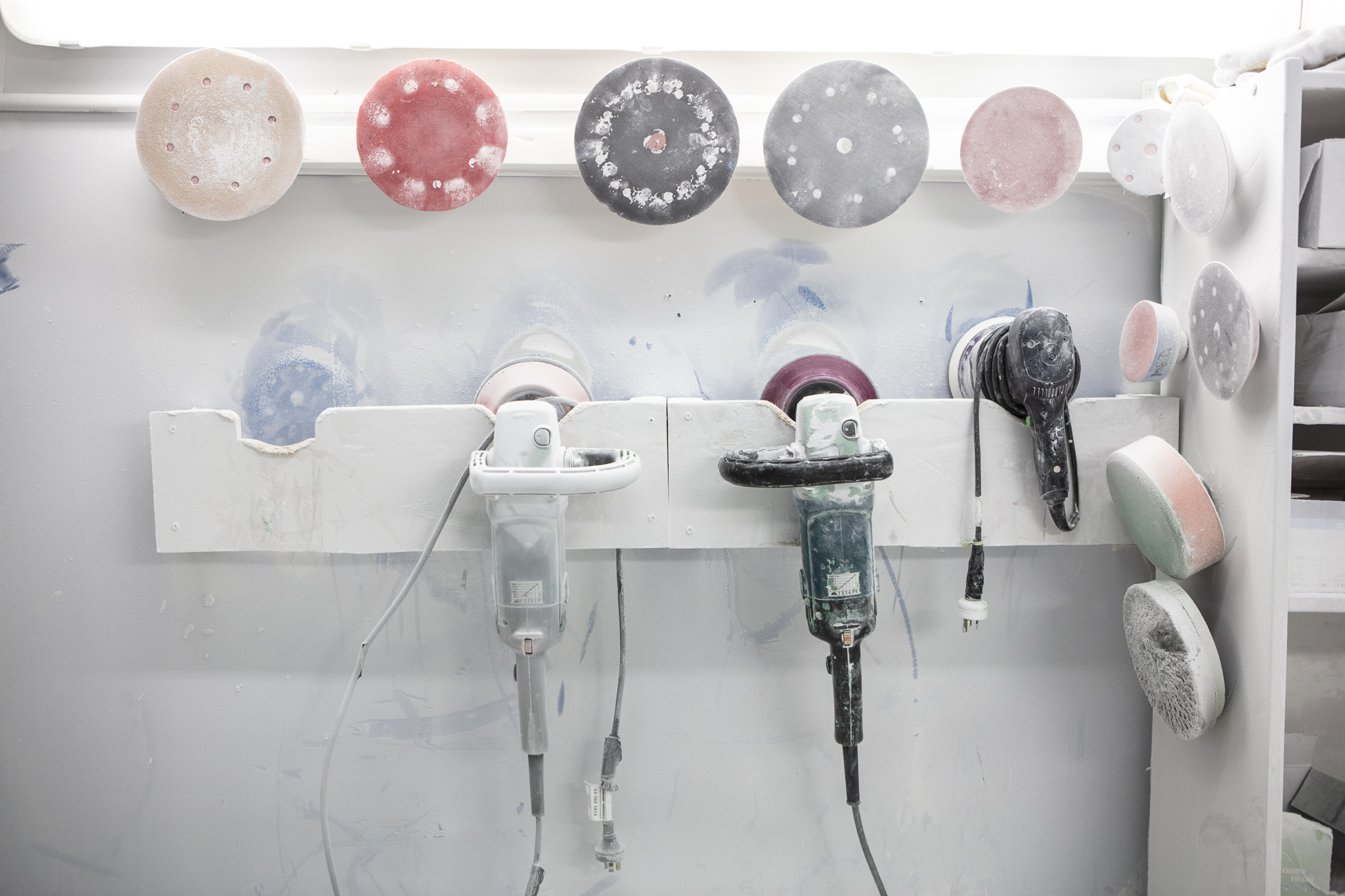
Rules were never part of surfing and Jay is quick to illustrate why they don’t belong.
“There was a point in time, when guys would say, ‘Oh, you can’t ride that, it’ll ruin your surfing’ or, ‘I can’t go snowboarding it ruins your surfing’,” he recalls shaking his head. “Now you’ve got guys like [surfboard shaper Chris] Christenson that are doing collabs with Jeremy Jones, making surfboard snowboards. That thing’s been going on for a little while, but it’s become quite popular now that we have this whole ride mentality. I think it’s really, really good.”
“You can have your mindset that you really want to go hard and push yourself and perform or whatever. But these days you just want to relax. You can fill those voids by just opening the garage door and having it all in front of you,” he adds. “You don’t have to behave in a certain way. And it doesn’t ruin your surfing at all. It actually teaches you the function points of how surfboards work. You can actually feel your width, your rails, where your feet are, where the trim line is, how your rocker works – everything. The V and tail – how your concaves work – all by riding different surfboards. I think that’s healthy.”
“You don’t have to behave in a certain way. And it doesn’t ruin your surfing at all. It actually teaches you the function points of how surfboards work. You can actually feel your width, your rails, where your feet are, where the trim line is, how your rocker works – everything. The V and tail – how your concaves work – all by riding different surfboards. I think that’s healthy.”
According to Jay even riding a longboard helps your shortboard surfing.
“You start learning to swing,” he shows me, mimicking the movement. “There’s a lot more weight to throw around and it just slows down the motion of how you ride a board. It’s a really healthy place where the longboard sits in the playing field now, too. It wasn’t that long ago that you had to be old and over 50 to ride a longboard – and then you were an old kook and you had stones thrown at you. It’s not like that anymore.”
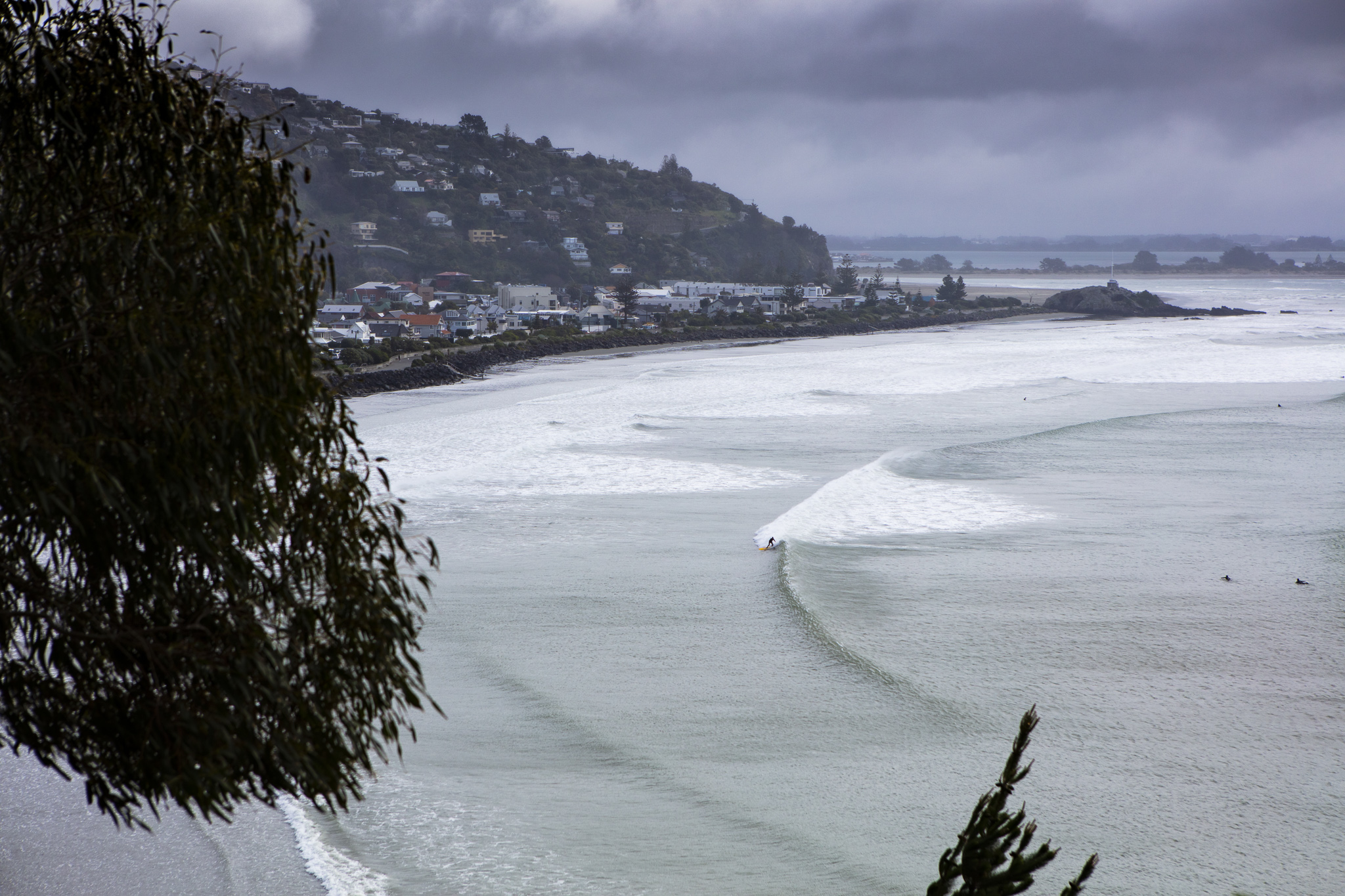
And that’s where Christchurch, which isn’t blessed with surf like other parts of the country, has corralled such a vibrant surfing community.
“Even Sumner has its magic moments,” Jay smiles. “If you look at it through a particular set of eyes, it can actually be really, really good. From a longboarding point of view, when it’s two, three foot and the east swell is right and the tide is right it can be magic.”
He points to the Single Fin Mingle as confirmation.
“There’s plenty of young guys and girls coming over from California and Hawaii for the Single Fin Mingle, which has turned into a pretty influential event on the New Zealand circuit,” he tells me. “Everyone is trying to mimic what’s going on down here with the Mingle in Sumner.”
Jay surveys the current state of surf culture with an open and curious mind that has its reference point rooted deeply in the wake-up that Litmus provided to a sluggishly conservative era of surfing back in the ’90s. I drill into the board selection he’s currently riding.
“My go-to board right now is probably the Coalminer,” he shares after a pause to consider his response. “I don’t get out as much as I used to since my daughter came along – so I tend to ride wider sort of fun shapes. I like the float and the feel. So why not take almost identical dimensions and rocker line, mix it up so that there is slightly more of a shortboard feel? Essentially if you drew them up together, the litreages are the same, the plan shapes aren’t too dissimilar, the wide points and everything is on the money. It just looks different. But it’s almost the same thing. That’s my thing for around here, but I do like a 6’6” single fin, pintail if it’s decent somewhere.”
For barrels, he told me he would go for a 6’0” single fin or a 6’6” performance board that he has at home.
“I like that mid-trim spot on a single. But, I’m not getting too many barrels at the moment,” he smiles.
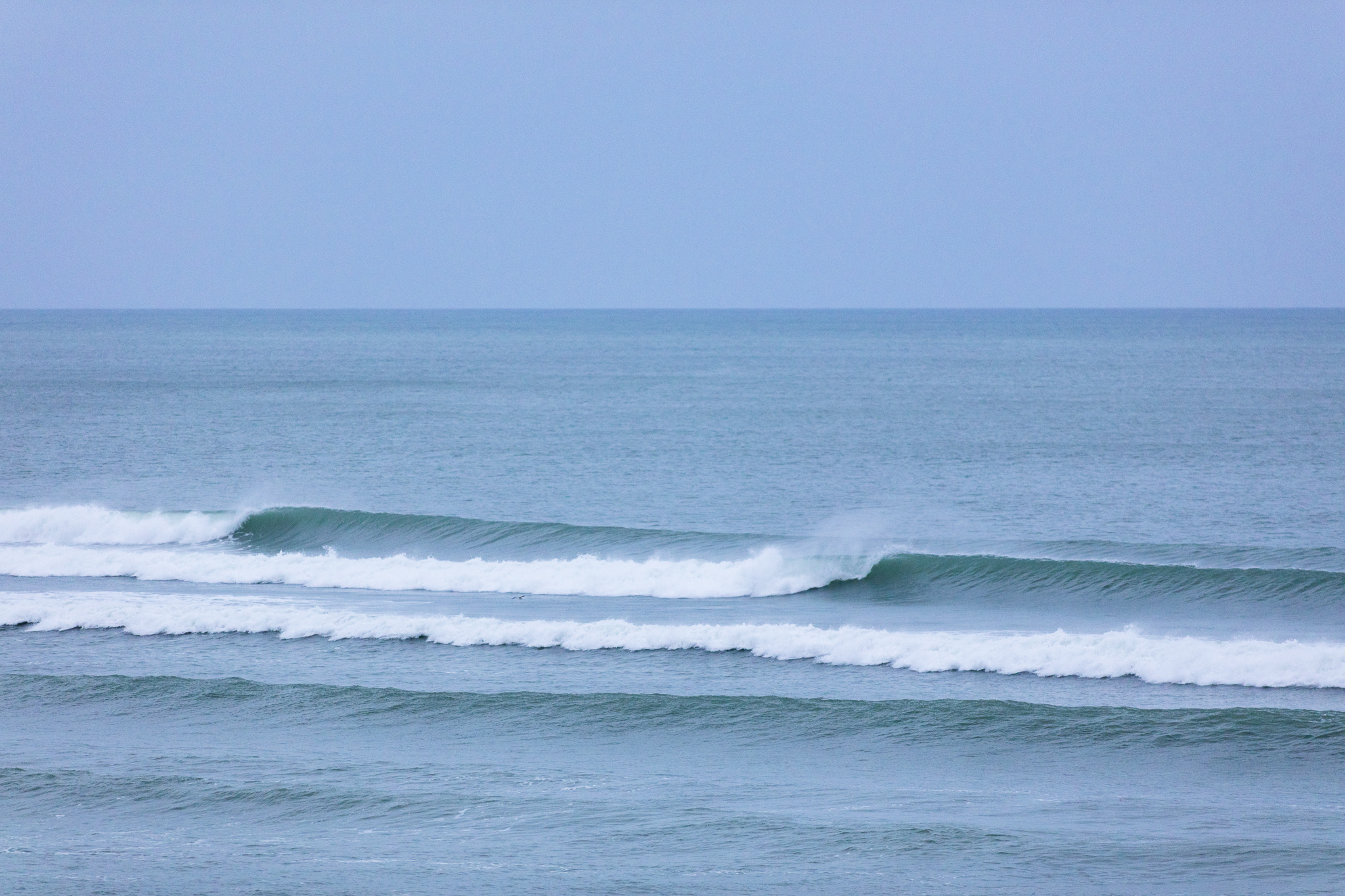
Winter is the quiet season for Sadhana Surfboards with only two or three boards being made each week.
“In the summer we make about eight to 10 boards a week,” reveals Jay as he shows me around the shaping bays, glassing and spray bays at the back of the shop. “I’ve got a glasser and a sander, but it fluctuates – this time of year the guys get a bit more time off. That’s the hard thing about the board trade – you have to do it because you love it. Then in summer, you’re flogging them with a whip,” he laughs.
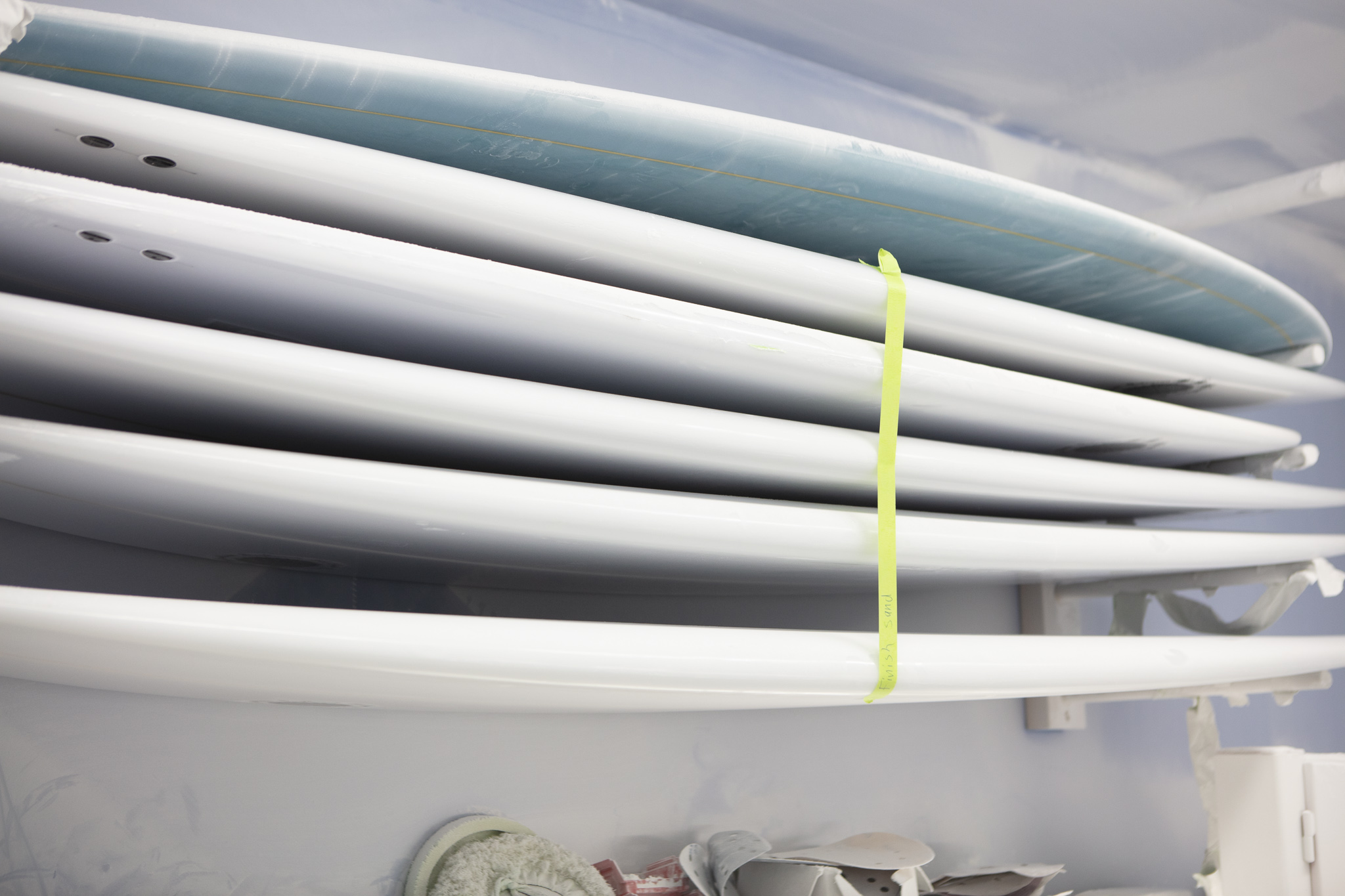
Jay also holds the South Island license for Bennett Foam Australia and supplies blanks and resin to Graham Carse, at Quarry Beach Surfboards, Homa, at Seer Surfcraft, and Surge, at Surge Surfboards, in Kaikoura along with a string of backyard shapers and hobbyists.
“We sell blanks, resin and shaping stuff as well now,” he adds. “Pete Anderson is doing it up north, but we’re supplying it here and we’re selling online – we’ve got a full online inventory now. It’s good because I’m mainly bringing them in for myself, but I get to share my product knowledge with other people as well.”
“That’s the other new thing,” he notes. “These past couple of years everyone is building boards again. Everyone is having a stab at it and why not? Everyone has a crack at it, but then they realize it takes years before you can actually do it well.”
He said that’s why shapers were the way they were.
“You know the old story – don’t go and see your local shaper because he’s usually pretty grumpy. I know why now,” he laughs. “I have my moments.”
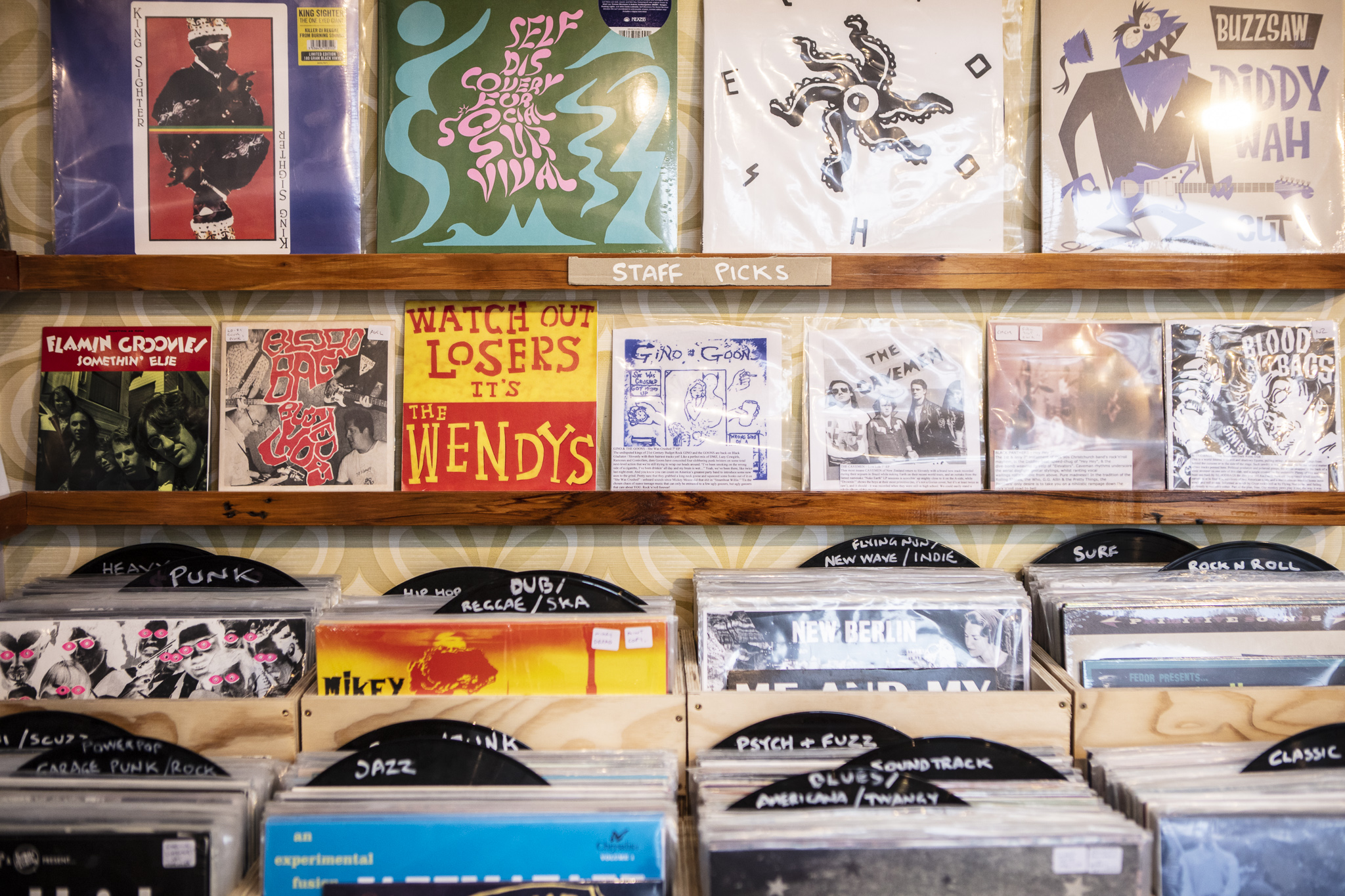
Inside his showroom a whole corner is dedicated to vinyl. I ask him at what point he decided it was time to put his vinyl collection on sale? He laughs.
“I suppose when we opened up down here we knew that not everyone that walks past a shopping mall in the middle of Woolston is looking for a surfboard,” he smiles. “It’s just another little fun point. I’ve got a few suppliers, who supply me stuff and it’s just something different – we wanted to have something different than your average surf shop. We had a policy that we wouldn’t buy in anything that wasn’t either made by us or anyone else we knew. We’ve stuck to that to a point. My wife does all the shirts and clothing, although she’s been a bit waylaid with the family lately.”
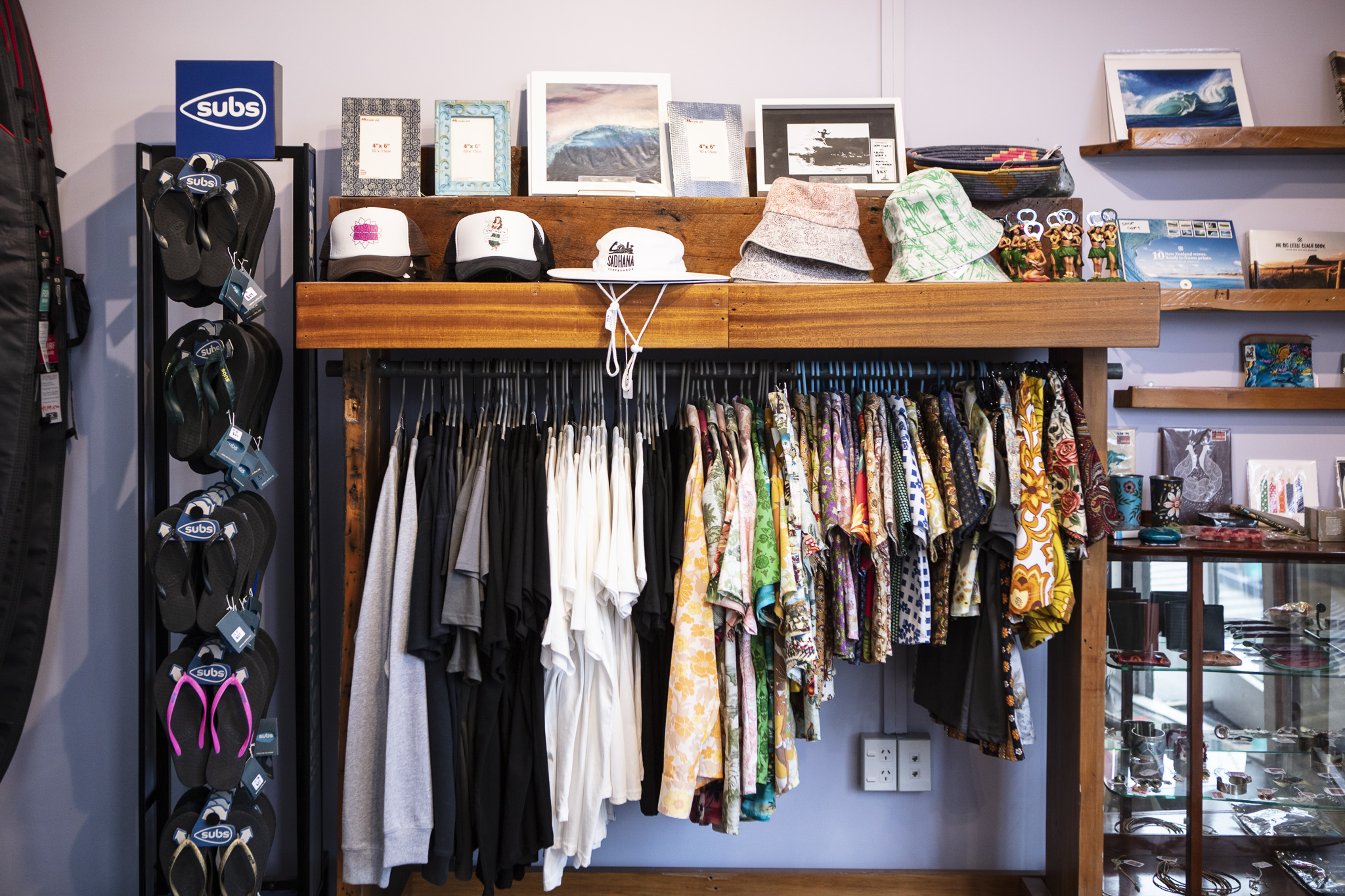
Jay and Hana’s daughter is only 14-months, but she’s born into some kind of surfing royalty. It’s tempered with enough mindfulness of being that she’ll undoubtedly lead a charmed life. If Jay has it his way, she’ll walk her own path the way he and Hana have carved their own life in New Zealand.
